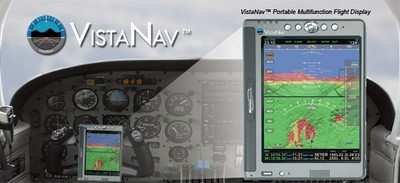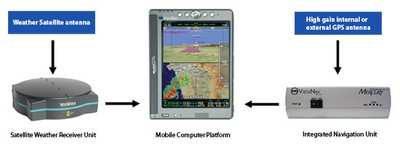Sun, Mar 05, 2006
 Mercury Computer Systems, Inc. has
released VistaNav version 1.5, its multi-function flight display
system with synthetic vision technology. This latest release of the
VistaNav system integrates XM satellite weather information
including NEXRAD Precipitation and Cloud information, Live TFRs,
METAR Flight Rules Indicators (FRI), as well as detailed METAR and
TAF text information.
Mercury Computer Systems, Inc. has
released VistaNav version 1.5, its multi-function flight display
system with synthetic vision technology. This latest release of the
VistaNav system integrates XM satellite weather information
including NEXRAD Precipitation and Cloud information, Live TFRs,
METAR Flight Rules Indicators (FRI), as well as detailed METAR and
TAF text information.
The VistaNav system provides the pilot with a complete portable
navigation solution including 3D Synthetic Vision,
Highway-in-the-Sky (HITS) Flight Path Guidance, 3D Terrain Views
and 3D Approach Display. In addition to its synthetic vision
features, VistaNav can display 2D navigation in either full or
split-screen formats.

"Adding XM weather to VistaNav’s three-dimensional
synthetic vision provides the pilot with a complete, portable
navigation solution and greatly enhances their ability to negotiate
both terrain and weather in challenging flight conditions," said
Philippe Roy, Director of the Visualization & Simulation Group,
Commercial Imaging and Visualization, Mercury Computer Systems.
"This combination of advanced 3D visualization technology and
state-of-the-art inertial navigation hardware delivers
unprecedented situational awareness to pilots in a portable cockpit
solution."

The VistaNav system includes an INU (Inertial Navigation Unit)
featuring 3D solid-state inertial sensors, a WAAS-enabled (Wide
Area Augmentation System) GPS receiver, and a Bluetooth®
wireless interface. The unit can be mounted in a number of places
inside an aircraft and communicates through a wireless interface
using a tablet PC mobile computing platform (MCP). The MCP has a
high-resolution 5"x 8" LCD display with a full navigation user
interface that allows pilots to manage all phases of flight, from
preparation to parking. The entire unit is powered by the aircraft
power supply and includes rechargeable batteries that will operate
for up to one hour in the event of an aircraft electrical failure.
Both the INU and MCP are designed to be removed or installed in an
aircraft in less than three minutes.
More News
Aero Linx: JAARS Nearly 1.5 billion people, using more than 5,500 languages, do not have a full Bible in their first language. Many of these people live in the most remote parts of>[...]
'Airplane Bounced Twice On The Grass Runway, Resulting In The Nose Wheel Separating From The Airplane...' Analysis: The pilot reported, “upon touchdown, the plane jumped back>[...]
"Burt is best known to the public for his historic designs of SpaceShipOne, Voyager, and GlobalFlyer, but for EAA members and aviation aficionados, his unique concepts began more t>[...]
"Polaris Dawn, the first of the program’s three human spaceflight missions, is targeted to launch to orbit no earlier than summer 2024. During the five-day mission, the crew >[...]
There Are SO Many Ways To Get YOUR Aero-News! It’s been a while since we have reminded everyone about all the ways we offer your daily dose of aviation news on-the-go...so he>[...]
 ANN's Daily Aero-Linx (05.04.24)
ANN's Daily Aero-Linx (05.04.24) NTSB Final Report: Quest Aircraft Co Inc Kodiak 100
NTSB Final Report: Quest Aircraft Co Inc Kodiak 100 Aero-News: Quote of the Day (05.04.24)
Aero-News: Quote of the Day (05.04.24) Aero-News: Quote of the Day (05.05.24)
Aero-News: Quote of the Day (05.05.24) Read/Watch/Listen... ANN Does It All
Read/Watch/Listen... ANN Does It All





